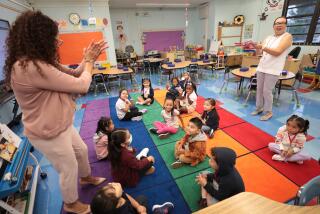Calif. Slides From 9th to 33rd in School Funding, NEA Says : Federal Aid to Education Put at 2-Decade Low
- Share via
WASHINGTON — California has slipped from 9th to 33rd place nationwide over the last five years in its financial support of public education, the president of the National Education Assn. said today.
“California is now lagging far behind many of our poorer states as far as funding and quality of education are concerned,” NEA President Mary Hatwood Futrell said in releasing the NEA’s annual report on national school enrollment, teachers’ salaries and school funding.
According to the report, the average salary for the nation’s 2.2 million public school teachers is now $26,704, and the cost of educating each student in grade and high school is just under $4,000 a year.
Federal Share Falls
The nation’s largest teacher union, in its annual compendium of school statistics, also reported that the federal share of the public school budget has dropped to its lowest level in more than two decades: 6.2%.
Futrell told a news conference that teacher salaries, which have doubled in the last decade, “have only been playing catch-up.” Increases in school budgets, which have been going up 6% to 9% each year in the 1980s, “do little more than leave schools treading water,” Futrell said.
She lambasted the Reagan Administration and several states, including California, where she said teachers and students are being hurt by tight budgets. She said other states are raiding Louisiana and Mississippi, where salaries are below average, to hire teachers, and said California schools are suffering from Proposition 13, the 1978 referendum that clamped a lid on property taxes.
Compton Schools ‘Terrible’
Futrell said the condition of schools she visited last month in the largely minority Compton Unified School District outside Los Angeles was “absolutely terrible,” including a classroom with bird droppings that came through a hole in the ceiling, foul bathrooms, broken windows and classes with more than 40 students.
On the other hand, she praised the efforts South Carolina, Ohio and Missouri have made to bolster their schools.
“The public is clamoring for education reform, yet education revenues are barely keeping pace with inflation and federal funding is on the decline. It’s time to take a good look at what’s needed to bring about real education reform,” she said in a statement.
20% Increase Urged
The NEA contends that taxpayers will have to pump 20% to 25% more money into teacher salaries and other public school expenses each year if they want to see dramatic improvements in children’s learning.
Public school revenues were up by nearly $10 billion, or 6.3%, to $160.9 billion for the 1986-87 school year. Since 1976-77, school revenues have shot up 114%.
But adjusting for inflation, “public school revenues increased by only 13.8% over the decade,” according to the NEA report “Estimates of School Statistics: 1986-87.”
Bill Kristol, chief of staff to Secretary of Education William J. Bennett, dismissed Futrell’s criticisms, saying that total national spending on the schools has gone up every year.
More to Read
Sign up for Essential California
The most important California stories and recommendations in your inbox every morning.
You may occasionally receive promotional content from the Los Angeles Times.










